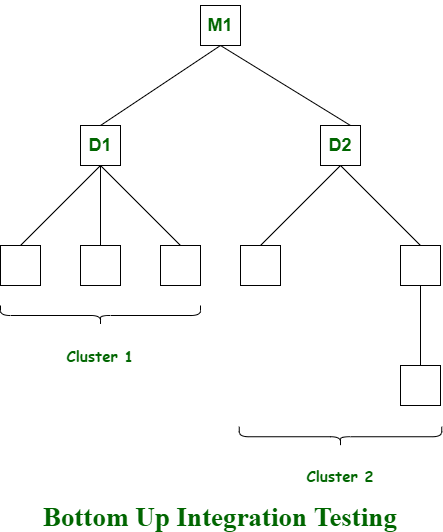Steps in Bottom Up Integration Testing
Last Updated :
07 Mar, 2024
Bottom-up Testing is a type of incremental integration testing approach in which testing is done by integrating or joining two or more modules by moving upward from bottom to top through the control flow of the architecture structure. In these, low-level modules are tested first, and then high-level modules are tested. This type of testing or approach is also known as inductive reasoning and is used as a synthesis synonym in many cases. Bottom-up testing is user-friendly testing and results in an increase in overall software development. This testing results in high success rates with long-lasting results.
Steps of Bottom-Up Integration Testing
Following are the steps that are needed to be followed during the processing :
- Clusters are formed by merging or combining low-level modules or elements. These clusters are also known as builds that are responsible for performing certain secondary or subsidiary functions of software.
- It is important to write a control program for testing. These control programs are also known as drivers or high-level modules. It simply coordinates the input and output of a test case.
- Testing is done on the entire build or cluster containing low-level modules.
- lastly, the control program or drivers or high-level modules are removed and clusters are integrated by moving upward from bottom to top in the program structure with the help of control flow.
Example of Bottom-Up Integration Testing
In the last, modules or components are combined to form cluster 1 and cluster 2. After this, each cluster is tested with the help of a control program. The cluster is present below the high-level module or driver. After testing, the driver is removed and clusters are combined and moved upwards with modules.

Bottom-Up Integration Testing
Advantages of Bottom-Up Integration Testing
- It is easy and simple to create and develop test conditions.
- It is also easy to observe test results.
- It is not necessary to know about the details of the structural design.
- Low-level utilities are also tested well and are also compatible with the object-oriented structure.
Disadvantages of Bottom-Up Integration Testing
- Towards the top of the Hierarchy, it becomes very complicated.
- There is no concept regarding the early skeletal system.
- There will be an impact on sibling and higher-level unit tests due to changes.
Like Article
Suggest improvement
Share your thoughts in the comments
Please Login to comment...